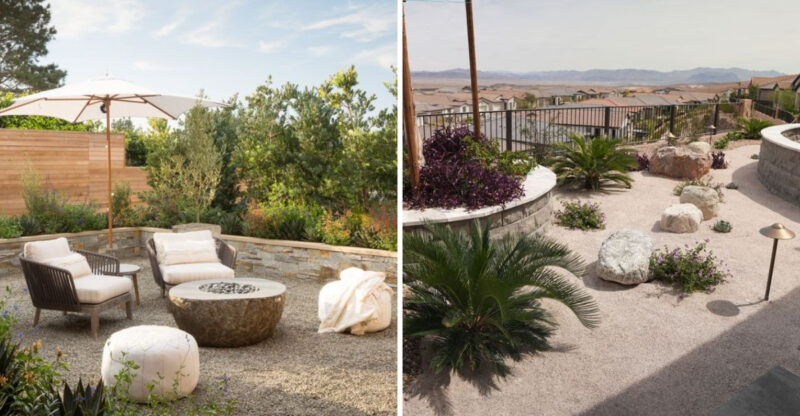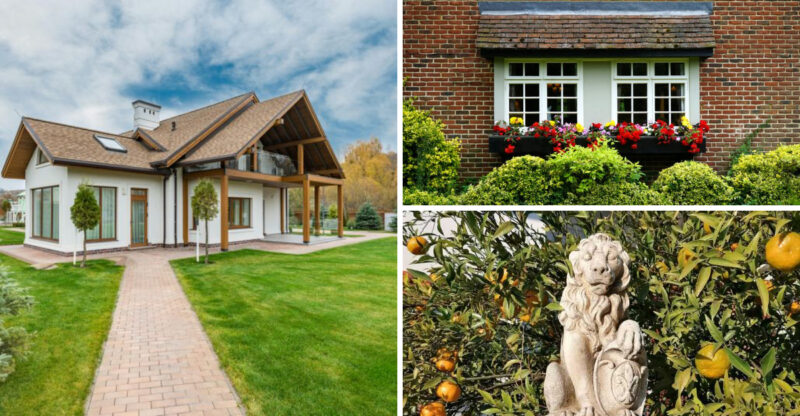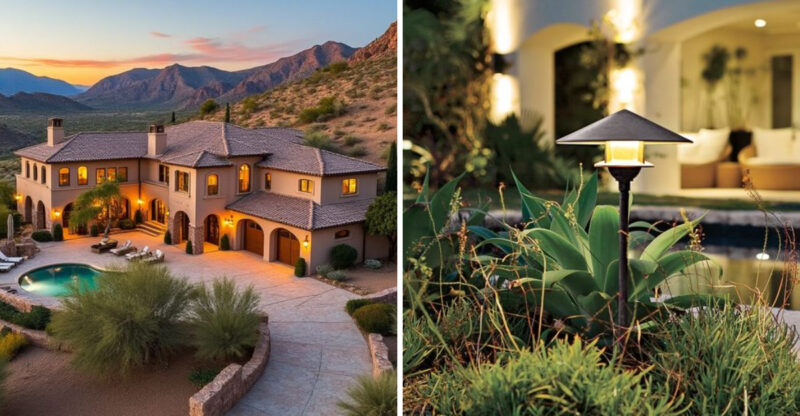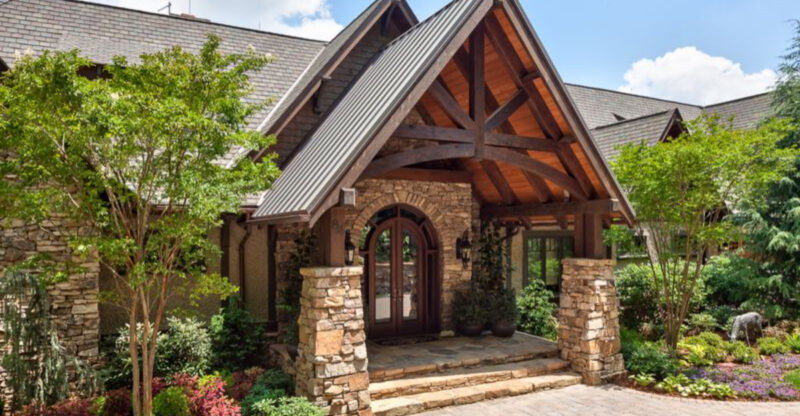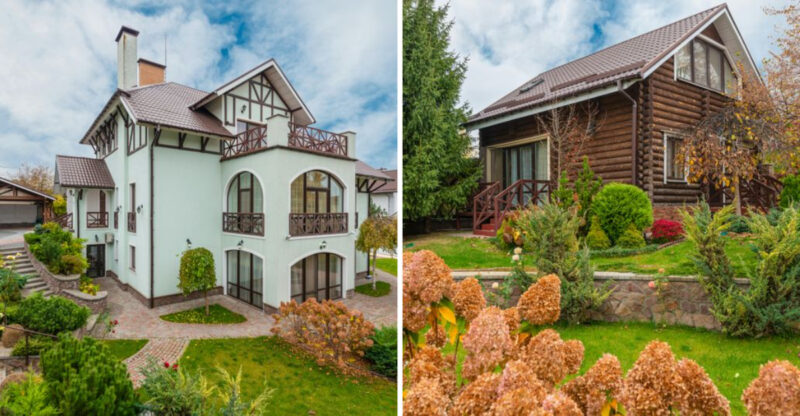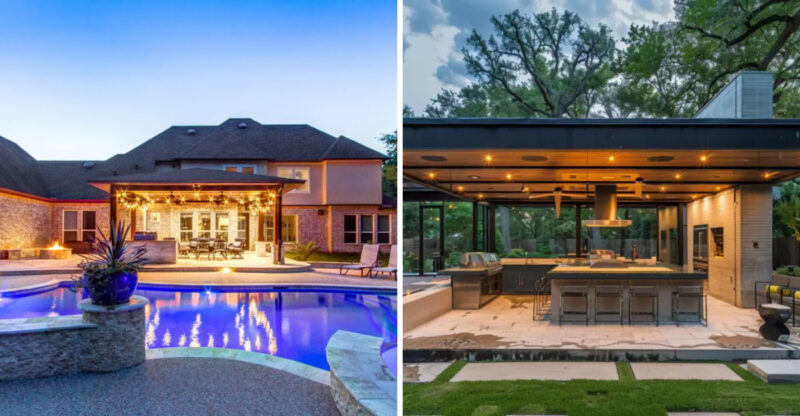7 Common Porch Eyesores According To Designers And 6 Beautiful Alternatives
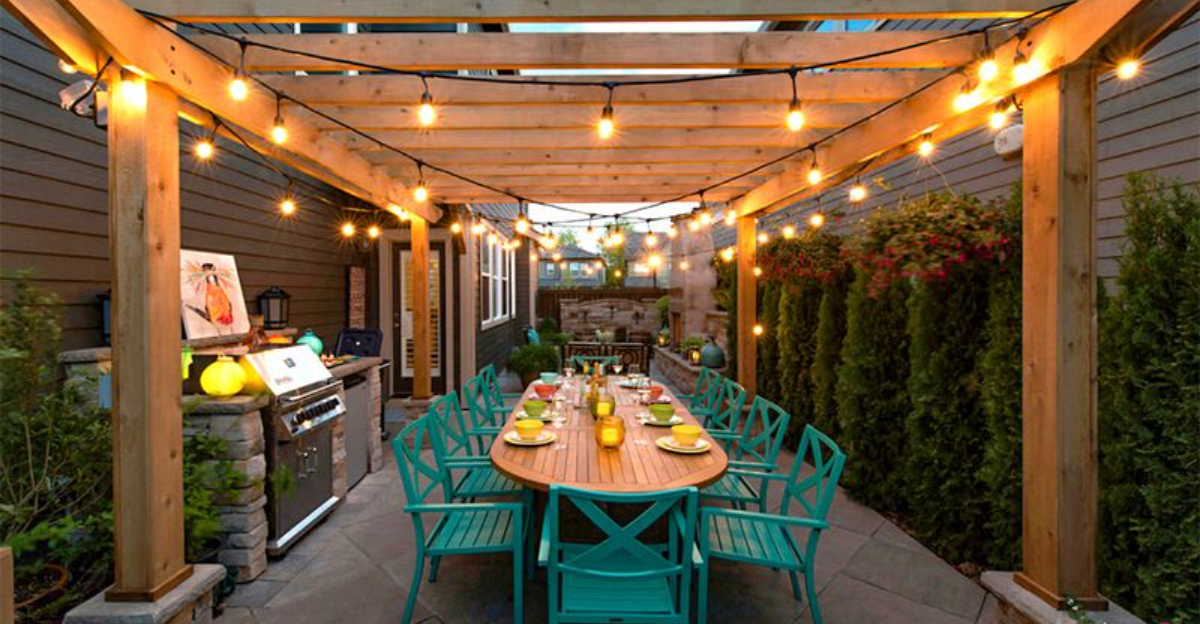
Your porch is the first impression visitors get of your home, yet it’s often neglected until eyesores take over.
I’ve seen countless porches that could be showstoppers transformed into cluttered, worn-out spaces that detract from a home’s charm. The good news?
With some thoughtful updates, you can easily transform these common eyesores into inviting outdoor havens that welcome guests and provide you with a beautiful space to enjoy.
1. Peeling Paint
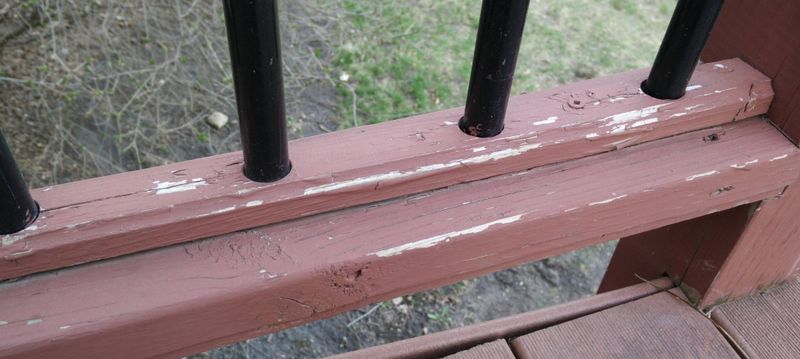
Nothing screams neglect louder than paint flaking off your porch railings and floor. Weather exposure gradually breaks down even quality paint, leaving your outdoor space looking shabby and unkempt. The constant cycle of sun, rain, and temperature changes makes porches particularly vulnerable to this common problem.
Beyond just looking bad, peeling paint can actually damage the underlying wood by allowing moisture to seep in. This often leads to rot and structural issues if left untreated for too long. Plus, those little paint chips create a constant mess that gets tracked into your home.
Most homeowners put off repainting because it seems like a huge project, but catching it early means less prep work and a quicker refresh. A weekend of sanding and painting can add years to your porch’s life and dramatically boost your home’s curb appeal.
2. Broken Railings
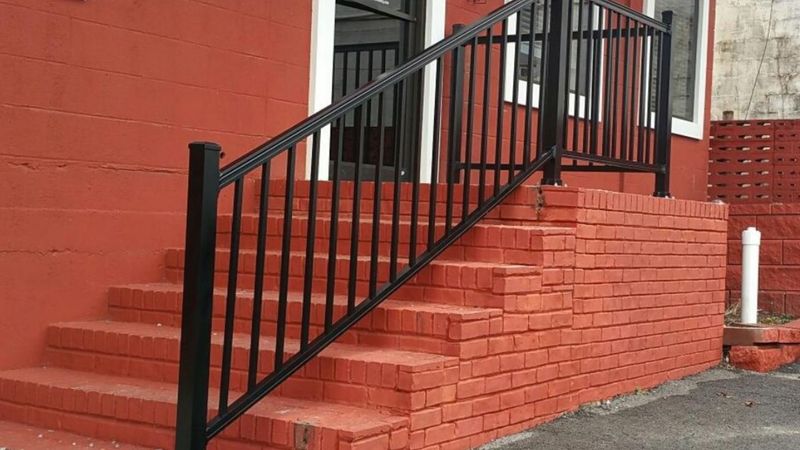
Wobbly, cracked, or missing balusters aren’t just eyesores they’re serious safety hazards. When guests grab a railing that gives way, accidents happen fast. Designers cringe when they see these structural elements falling apart because they undermine your entire porch aesthetic.
Kids and pets are particularly vulnerable to gaps in railings that don’t meet code requirements. Even small breaks can catch clothing or cause splinters. The problem often starts small perhaps a single loose spindle but quickly spreads as connecting pieces become unstable.
Replacing damaged railings might seem costly upfront, but consider it an investment in both safety and style. Modern railing systems come in materials ranging from traditional wood to low-maintenance vinyl, powder-coated aluminum, or even cable systems that provide safety without blocking your view.
3. Cluttered Space
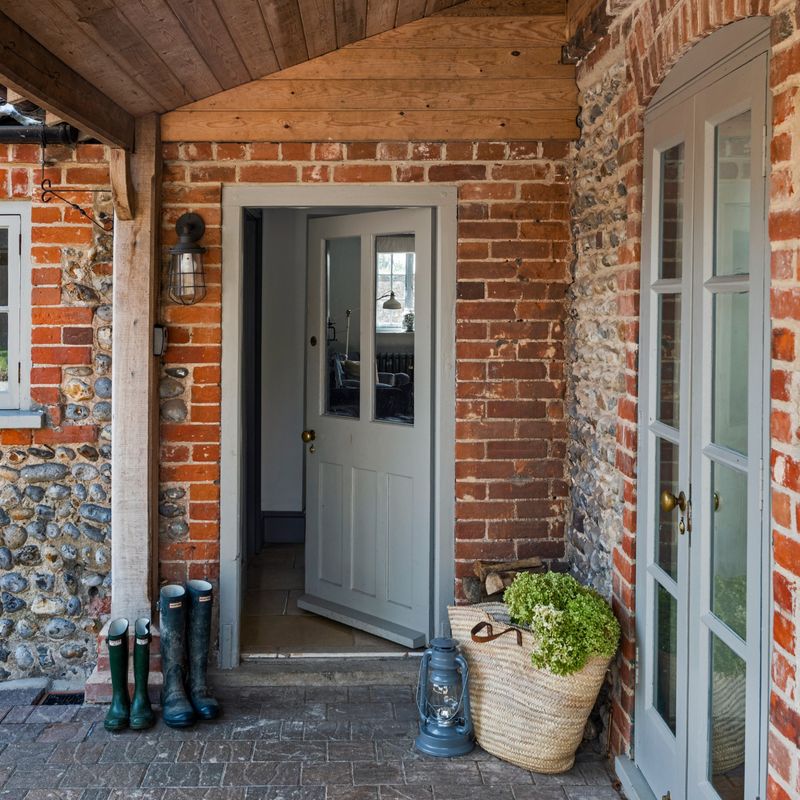
Your porch isn’t meant to be an extension of your storage room! Random shoes piled by the door, empty planters from three seasons ago, and that broken chair you keep meaning to fix create visual chaos that greets everyone who visits. Designers consistently rank clutter as the fastest way to ruin porch potential.
Many homeowners don’t realize how quickly small items accumulate in this transitional space. The garden hose never gets properly stored, Amazon packages wait for unpacking, and seasonal decorations somehow never make it back to storage. This gradual buildup happens because we pass through porches rather than truly living in them.
A ruthless decluttering session can reclaim this valuable square footage in just an hour. Implement a simple “one in, one out” rule to maintain order going forward, and suddenly your porch becomes a place to enjoy rather than hurry through.
4. Faded Furniture
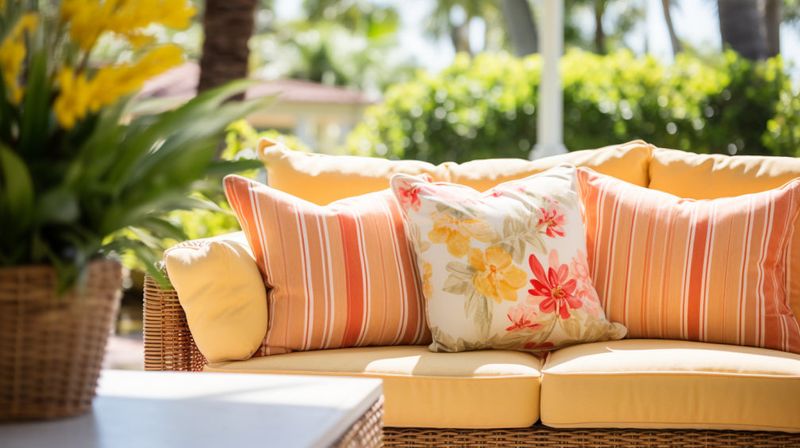
Remember those vibrant chairs you bought three summers ago? Now they’re a sad, washed-out version of their former selves. Sun exposure mercilessly bleaches fabrics and degrades materials, turning once-stylish furniture into depressing porch accessories that age your home’s appearance.
Faded cushions develop that telltale chalky residue that rubs off on clothing. Plastic furniture becomes brittle and develops hairline cracks that catch on clothing. Even quality wicker and metal pieces lose their luster when left unprotected against harsh elements year after year.
If you’ve invested in outdoor furniture, protect that investment with covers during harsh weather. For pieces past their prime, consider refreshing with outdoor-specific spray paint formulated to resist UV damage. Quality outdoor fabrics have come a long way today’s options resist fading for years while still feeling soft and comfortable.
5. Overgrown Plants
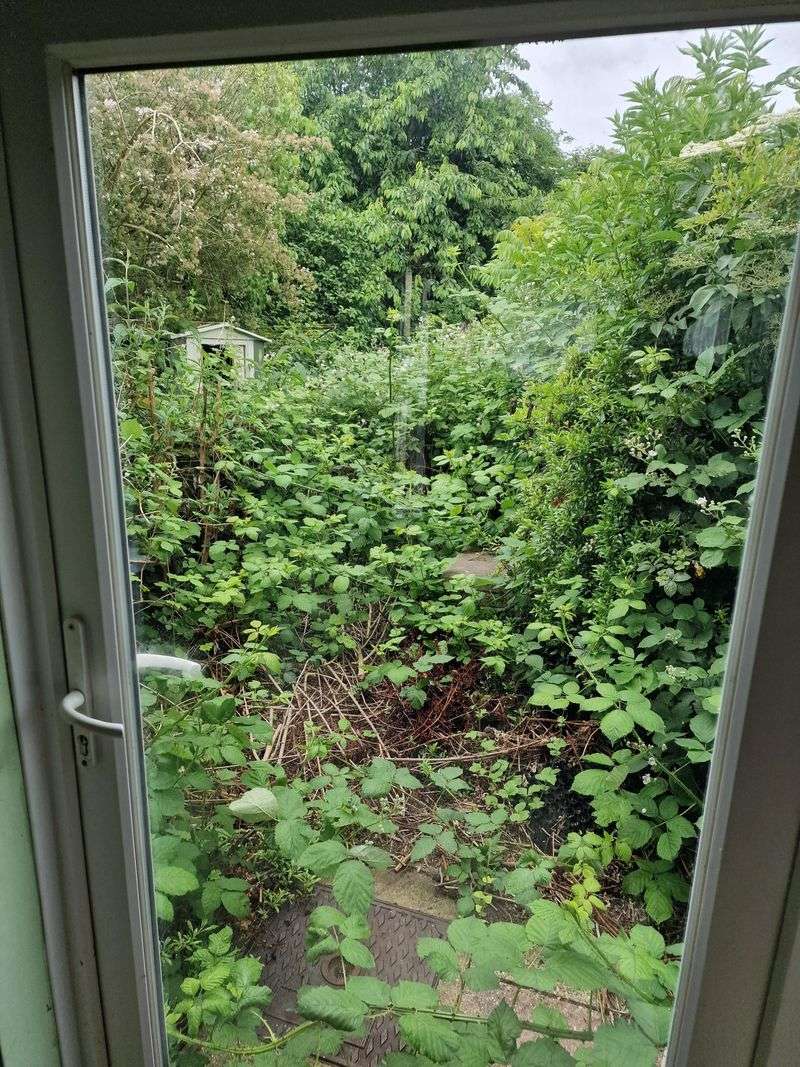
That cute little potted fern has morphed into a monster that swallows half your seating area. Untamed greenery quickly transforms from charming accent to wild jungle that makes your porch feel cramped and unkempt. Vines meant to add character now threaten to pull down your trellis entirely.
When plants outgrow their welcome, they create maintenance headaches too. Fallen leaves clog gutters, roots crack containers, and wayward branches scratch visitors. Overgrown plants also block natural light from reaching your porch and adjacent indoor spaces, making everything feel gloomy.
Strategic pruning can reclaim your space quickly. Consider replacing mammoth specimens with appropriately-sized varieties that won’t overwhelm your porch dimensions. Remember that plants should enhance your outdoor living, not dominate it the best porch greenery complements rather than competes with your seating and walkways.
6. Worn Flooring
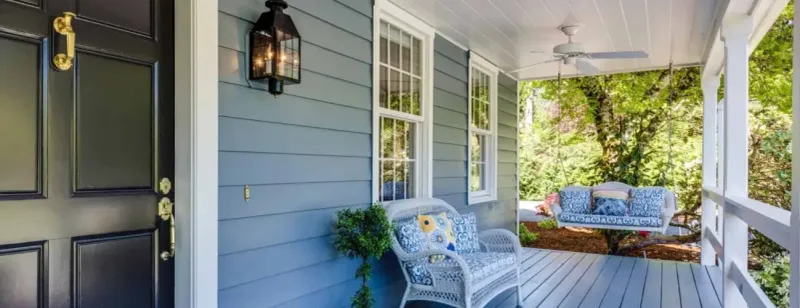
Every scuff, stain, and splinter on your porch floor broadcasts neglect to visitors before they even reach your door. High-traffic areas wear down first, creating uneven pathways that can become trip hazards. Moisture damage causes boards to cup and warp, while sun exposure fades even the most durable finishes.
Gaps between boards collect dirt and debris that’s nearly impossible to clean properly. When water seeps into these cracks, it accelerates deterioration from underneath. The constant expansion and contraction from temperature changes loosens fasteners, creating squeaky boards and potential nail pops.
Refinishing wood porch floors every few years prevents major damage and extends their lifespan dramatically. For severely damaged floors, new composite decking materials offer the look of wood with fraction of the maintenance requirements. Some innovative floating deck tiles can even be installed right over existing damaged flooring for a quick weekend transformation.
7. Rusty Fixtures
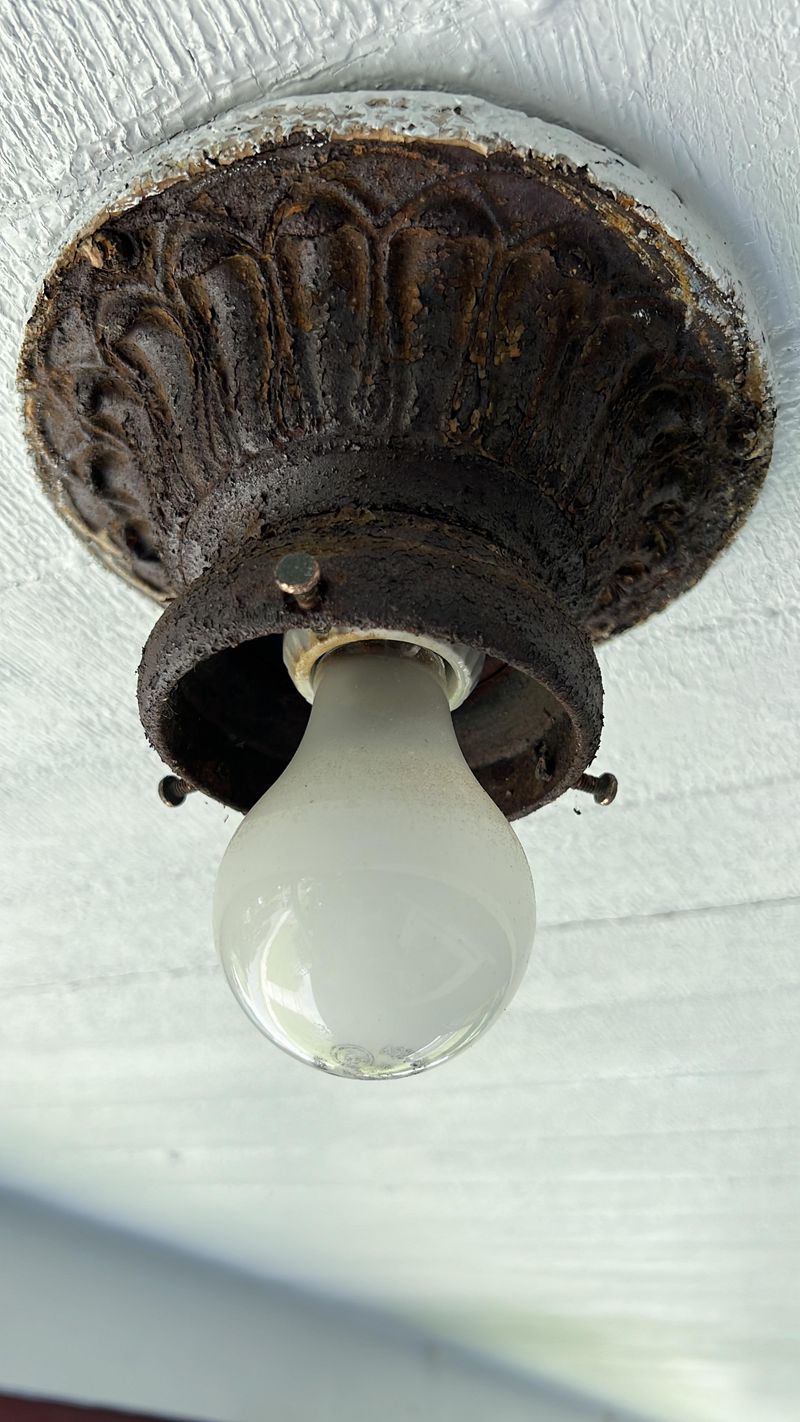
Corroded light fixtures, mailboxes, and hardware create an instant impression of neglect. Rust stains that bleed down your siding or posts are particularly unsightly and difficult to remove. Even expensive fixtures eventually succumb to the elements without proper maintenance.
Beyond the aesthetic problems, rusty fixtures pose functional issues too. Corroded light fixtures can short out, creating safety hazards. Rusty hardware weakens over time, potentially failing when you need it most. The orange-brown discoloration stands out dramatically against most home exteriors, drawing attention to deterioration.
When selecting replacement fixtures, look for marine-grade finishes specifically designed for coastal environments – these hold up even in the harshest conditions. For existing fixtures showing early signs of rust, wire brushing followed by rust-inhibiting primer and quality outdoor paint can extend their life. Remember that prevention is easier than cure – regular cleaning prevents salt and moisture buildup.
8. Hanging Plants (Beautiful Alternative)
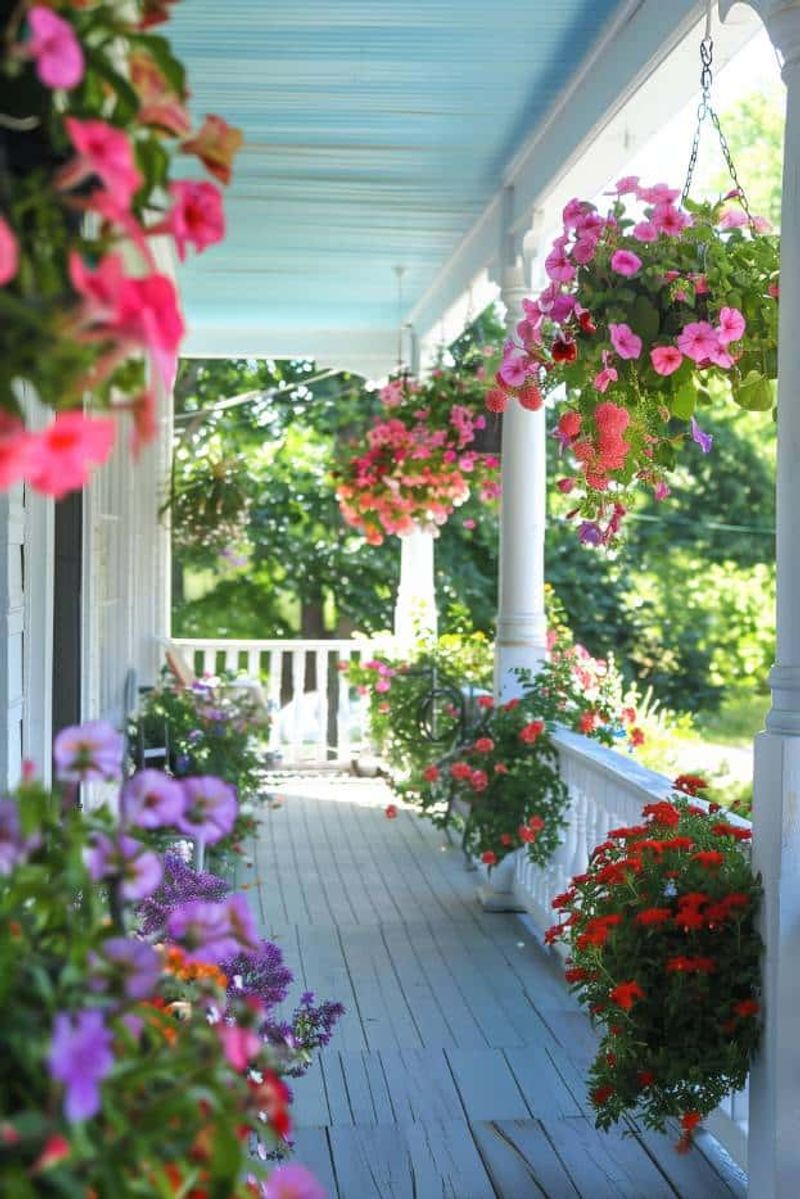
Hanging baskets instantly draw the eye upward, creating vertical interest that makes even small porches feel more spacious and designed. Unlike cluttered potted arrangements, these elevated beauties keep floor space clear while adding lush greenery exactly where you want it.
The gentle swaying movement adds a dynamic element that static decorations can’t match. Trailing varieties like ferns, ivy, or petunias create living curtains that soften harsh architectural lines. The cascading effect frames views rather than blocking them, enhancing your porch’s connection to the surrounding landscape.
Modern hanging systems make maintenance simple with self-watering reservoirs and swivel hooks for easy rotation. For year-round appeal, mix seasonal flowers with evergreen varieties that maintain interest through winter months. Even apartment dwellers with tiny balconies can utilize this space-saving solution to create their own hanging garden retreat.
9. Fresh Paint (Beautiful Alternative)
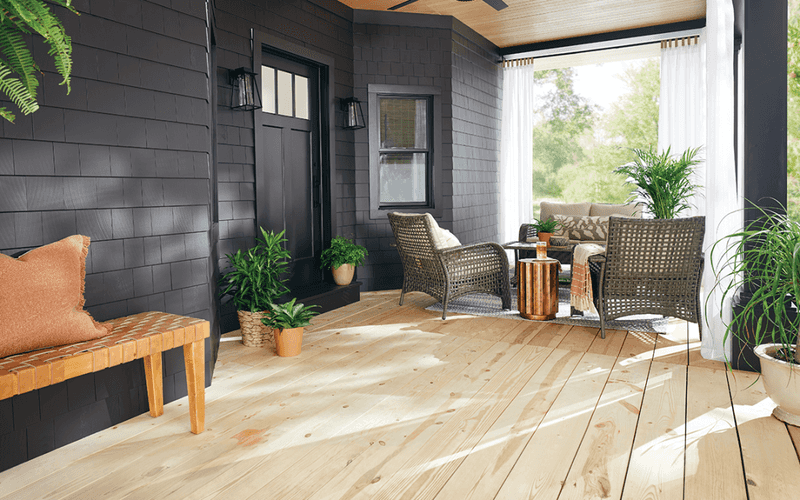
A fresh coat of paint works magic on tired porches, instantly erasing years of wear with relatively minimal investment. Bold color choices can transform your entrance from forgettable to statement-making overnight. Designers often recommend unexpected ceiling colors soft blues or even black to add architectural interest.
Modern exterior paints offer impressive durability with specialized formulations that resist mildew, fading, and peeling far better than products from even a decade ago. Some incorporate subtle texture that hides imperfections in older surfaces. The right sheen matters too semi-gloss finishes on trim elements reflect light beautifully while making cleaning easier.
Don’t overlook the impact of accent colors on small elements like shutters, door frames, or stair risers. These unexpected pops of color create visual interest without overwhelming the space. For timeless appeal that won’t quickly date your home, consider historical color palettes specifically developed for architectural styles like Victorian, Craftsman, or Colonial.
10. Cozy Seating (Beautiful Alternative)
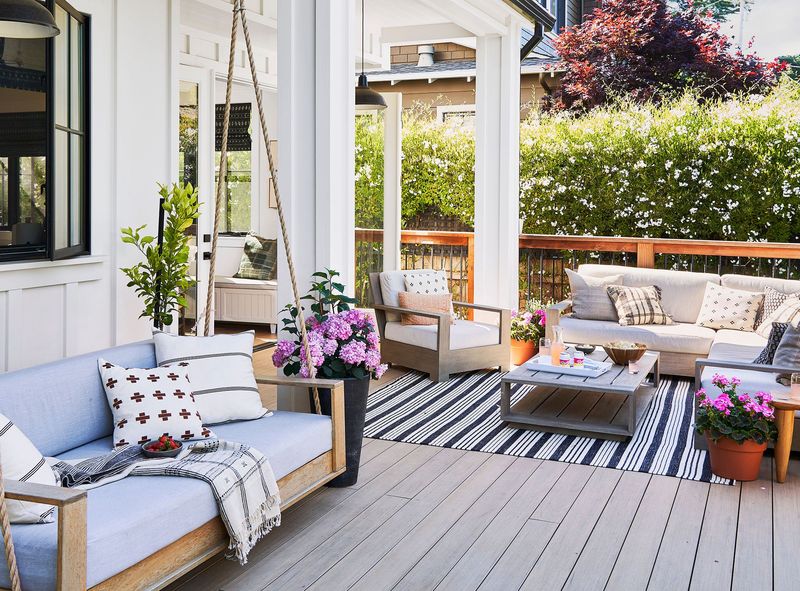
Thoughtfully arranged seating transforms a pass-through space into a true outdoor room where memories are made. Unlike the rigid plastic chairs of yesteryear, today’s outdoor furniture rivals indoor pieces for comfort and style. Weather-resistant materials have evolved dramatically, offering plush cushions that dry quickly after rain.
Arranging furniture in conversation groupings rather than lining pieces against walls instantly creates a more inviting atmosphere. Even tiny porches can accommodate a compact loveseat or pair of chairs positioned to take advantage of views or breezes. Scale matters tremendously oversized pieces overwhelm small porches while dainty furniture looks lost on grand verandas.
For maximum flexibility, consider modular pieces that can be reconfigured as needs change. Hidden storage within seating solves the clutter problem while keeping throws and pillows handy. The most successful porch seating entices family members away from screens and into the fresh air for conversations that strengthen connections.
11. Potted Flowers (Beautiful Alternative)
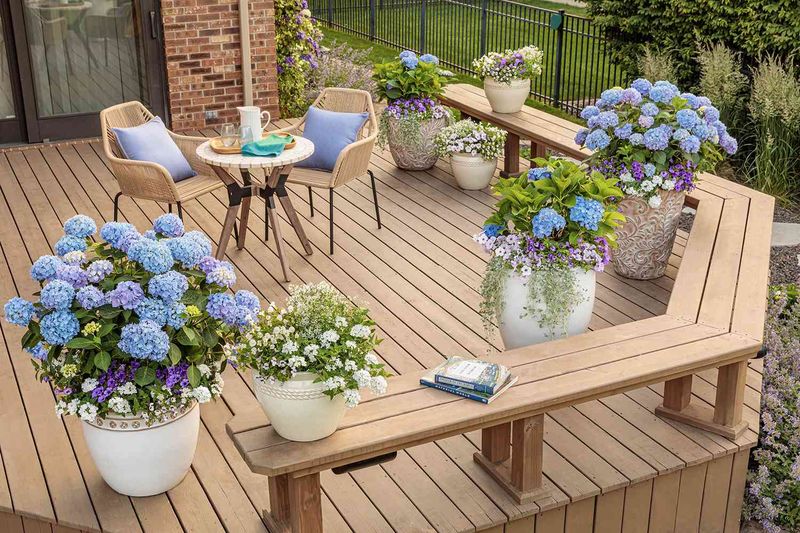
Strategic container gardens create focal points that draw attention away from architectural flaws while adding living color to your porch. Unlike overgrown beds, potted arrangements stay neatly contained and can be easily refreshed when seasons change. The elevated height puts blooms at eye level where their beauty and fragrance can be fully appreciated.
Designers recommend grouping containers in odd numbers with varying heights for visual interest. Matching containers create cohesion even with different plant varieties. Modern self-watering pots with built-in reservoirs have revolutionized container gardening, reducing maintenance dramatically while improving plant health.
For year-round appeal, invest in a few architectural evergreens as anchor plants, then surround them with seasonal bloomers that can be swapped out quarterly. This approach provides consistent structure while allowing for creative expression through color changes. Even novice gardeners can maintain stunning container displays with today’s resilient plant varieties specifically bred for container performance.
12. Outdoor Rugs (Beautiful Alternative)
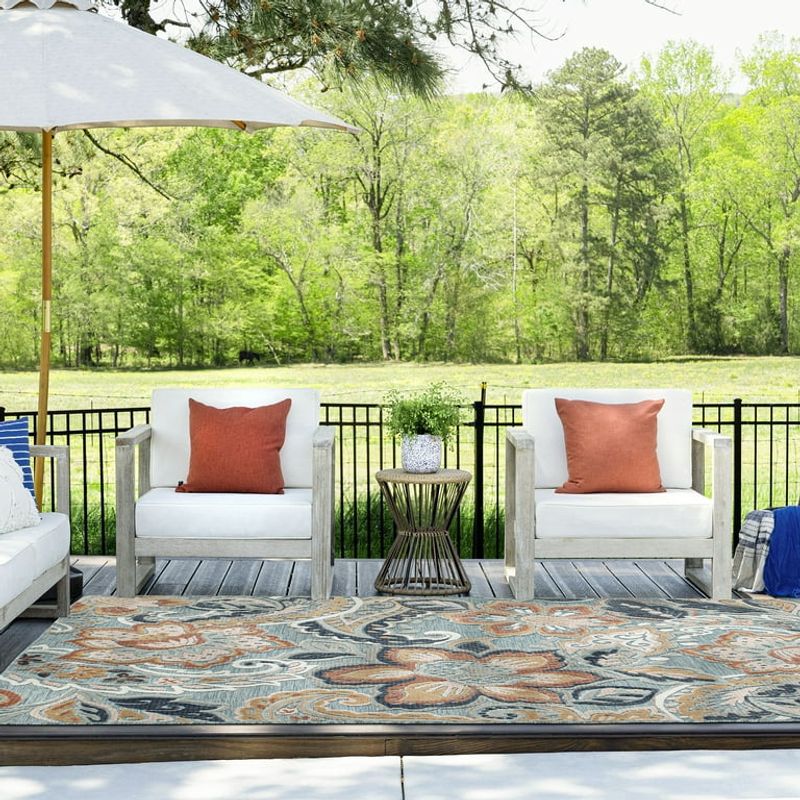
A well-chosen outdoor rug instantly defines your porch as an intentional living space rather than just a walkway. These hardworking textiles hide worn flooring while adding color, pattern, and texture underfoot. Unlike their indoor cousins, today’s outdoor rugs resist fading, mold, and mildew through innovative synthetic materials.
Proper sizing makes all the difference – undersized rugs create a postage-stamp effect that actually makes spaces feel smaller. Ideally, all furniture legs should rest on the rug or all legs should be off, avoiding the awkward half-on, half-off arrangement. Bold geometric patterns add contemporary flair while traditional designs complement historical homes beautifully.
Beyond aesthetics, outdoor rugs provide practical benefits by catching dirt before it enters your home and providing a softer surface for bare feet. Most can be cleaned with a simple hose-down, making maintenance nearly effortless. For maximum longevity, look for rugs made from recycled plastics – these eco-friendly options often outlast natural fiber alternatives while resisting stains remarkably well.
13. String Lights (Beautiful Alternative)
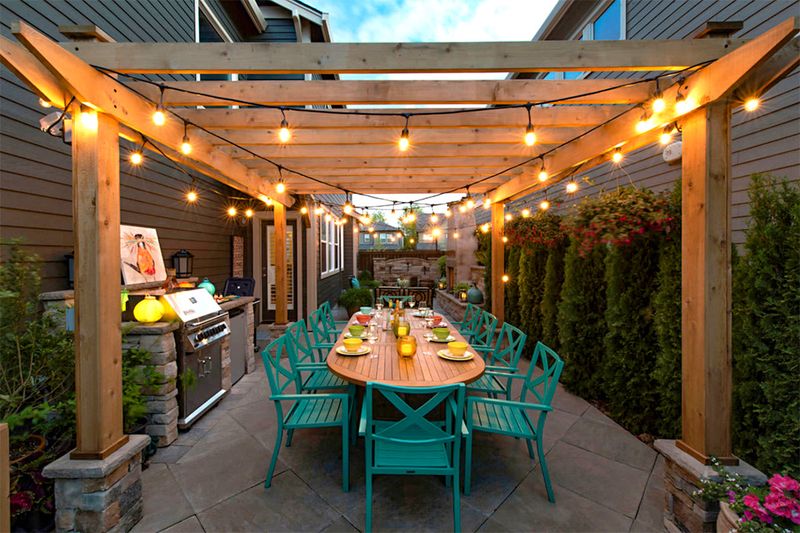
Twinkling string lights instantly transform ordinary porches into magical evening retreats. Unlike harsh floodlights that create unflattering shadows, these gentle illuminators cast a warm glow that flatters both people and architecture. The ambient light creates depth and dimension that makes even modest spaces feel more expansive.
Modern LED versions consume minimal electricity while lasting for years without bulb replacements. Weatherproof ratings ensure they stand up to elements year-round, eliminating seasonal installation hassles. Creative mounting options have evolved beyond simple straight lines try zigzag patterns overhead or wrapping porch columns for architectural emphasis.
Beyond their decorative appeal, string lights provide practical illumination for evening gatherings that might otherwise end when natural light fades. The psychological impact shouldn’t be underestimated either – their association with celebrations instantly puts guests in a festive mood. For year-round sophistication, choose simple white lights rather than multicolored varieties that may read as temporary holiday decorations.

